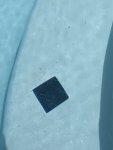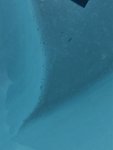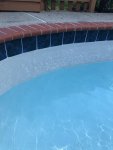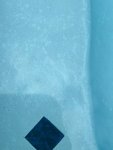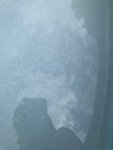Hello! July 2018 we had our pool plaster redone. We are in PA so enjoyed beautifully perfect plaster for less than 2 months before having to close for winter. When we got the new plaster, we followed instructions to the T- had water trucked in, we tested and balanced diligently with the LSI calculator, brushed the whole pool at least twice a day, etc. That first winter after closing the pool, the PH was always high which I understand is to be expected with new plaster. We checked weekly, and added acid as needed. With that said the ph is never below 7.6. Started to notice some spots on the plaster when we opened last summer, and asked the pool company who had no idea what it was- knowing that our water is always balanced, and if anything the ph runs high and never low (so we ruled out etching due to low ph). It basically looks like soft spots in the plaster, some areas are worse than others- like you can see the little sand bits that are mixed in more in the problem spots. It now basically covers the entire pool. I am pretty obsessive balancing the chemicals, I check daily so I know that is not the cause. I read on this forum that it could be spot etching- a result of poor plastering, adding too much calcium chloride (which the pool company says they don't use) or late troweling (denies this to be the case). The company we used has really good reviews, we did our research, and I feel that they are an honest company. The owner seems to have no idea that this is even possible- he had us add some stain remover last year which I knew would do nothing, and he does not seem to be too concerned, stating that plaster is an imperfect surface, etc.- is this something I should continue pursuing? I am not really sure what to do at this point. Photos attached, ignore the black marks from the pool robot 
Pool plaster- less than 2 years old. Spot etching?
- Thread starter hburke0525
- Start date
You are using an out of date browser. It may not display this or other websites correctly.
You should upgrade or use an alternative browser.
You should upgrade or use an alternative browser.
- Jul 21, 2013
- 65,340
- Pool Size
- 35000
- Surface
- Plaster
- Chlorine
- Salt Water Generator
- SWG Type
- Pentair Intellichlor IC-60
There are competing thoughts on the causes of "spot etching". Some will blame the plaster application, mix, troweling technique. Others will blame start-up, water chemistry, and ongoing maintenance. These competing sides both publish articles supporting their cases and arguing against the other side. In my opinion neither side can prove the others wrong and the debate will continue.
To OP; a few more pictures of the plaster spotting may help in identifying and determining what is going on with your pool.
As to the plaster debate; the side that claims that white streaking and spotting (known as “soft spotting” and “spot etching”) is caused by aggressive water do not have any cement laboratory and SEM reports supporting their position. Their own plaster test pool studies demonstrated that “white soft spotting” or “spot etching” did not develop in aggressive water conditions. Additionally, they had test pools that were subjected to balanced water which developed white spotting (spot etching) within four months.
On the other hand, our side has multiple professional cement laboratory and SEM reports showing that poor workmanship caused white spotting and streaks, and not by aggressive water. Furthermore, cement/concrete literature has identified improper workmanship that lead to various discolorations and defects. Aggressive water affects a quality-produced plaster/cement surface in a uniform and consistent manner, not in spots, streaks, or irregular patterns.
As to the plaster debate; the side that claims that white streaking and spotting (known as “soft spotting” and “spot etching”) is caused by aggressive water do not have any cement laboratory and SEM reports supporting their position. Their own plaster test pool studies demonstrated that “white soft spotting” or “spot etching” did not develop in aggressive water conditions. Additionally, they had test pools that were subjected to balanced water which developed white spotting (spot etching) within four months.
On the other hand, our side has multiple professional cement laboratory and SEM reports showing that poor workmanship caused white spotting and streaks, and not by aggressive water. Furthermore, cement/concrete literature has identified improper workmanship that lead to various discolorations and defects. Aggressive water affects a quality-produced plaster/cement surface in a uniform and consistent manner, not in spots, streaks, or irregular patterns.
Like most in the industry I am very familiar with research done by both sides. There can be more than one explanation for these type of plaster issues and in my opinion both sides have valid points. While I respect onblance I would say that this issue is far from solved, until both sides collaborate on a study like had been discussed in the past the debate will continue. The consumer is the one who is put in the middle and ends up with an etched pool or pays to have it redone.
@lasvegaspools
I am interested in learning what your position is on these plaster issues. But let's not hijack this thread.
I invite you to start a new thread in the section "Agree to Disagree" (if the TFP Mods will allow it), and you can present how there can be more than one explanation for these types of plaster issues. Or we can do it privately.
Also, as to a plaster study, we (onBalance) are currently building two test pools for experiments. (see www.poolhelp.com).
The other side (NPC) has refused to help out or contribute. We would welcome your help in any way.
We (onbalance) have been trying to help pool owners avoid being falsely accused of causing various plaster defects.
Thanks
I am interested in learning what your position is on these plaster issues. But let's not hijack this thread.
I invite you to start a new thread in the section "Agree to Disagree" (if the TFP Mods will allow it), and you can present how there can be more than one explanation for these types of plaster issues. Or we can do it privately.
Also, as to a plaster study, we (onBalance) are currently building two test pools for experiments. (see www.poolhelp.com).
The other side (NPC) has refused to help out or contribute. We would welcome your help in any way.
We (onbalance) have been trying to help pool owners avoid being falsely accused of causing various plaster defects.
Thanks
I think neither side is 100% correct and there is likely a combination of factors, plaster mix and water chemistry. The way this problem can be solved is for either side to make a pool spot etch in a set period of time with a specific water chemistry and plaster mix. Then be able to replicate it multiple times. This would not take multiple test pool and decades of planning by either side. This premise sounds fairly simple yet neither side has chosen to do this.
The back and forth has been going on for decades. Contractors, owners, and service companies are all blaming each other. This is the reason my answer when asked is I don't know, but my opinion is there are likely multiple factors.
The back and forth has been going on for decades. Contractors, owners, and service companies are all blaming each other. This is the reason my answer when asked is I don't know, but my opinion is there are likely multiple factors.
Here are some more photos. It is definitely worse in the shallow end around the stairs but it is all over. It doesn’t sand off and the whiter areas are slightly rougher where the sand kind of shows through, I think you can see that if you zoom into the step pic. Also more pronounced on step edges and right around the spot tile.
Attachments
-
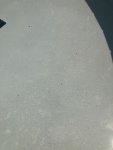 B5031414-02E3-4621-8DE7-E18B33473DE2.jpeg214.2 KB · Views: 75
B5031414-02E3-4621-8DE7-E18B33473DE2.jpeg214.2 KB · Views: 75 -
 4078DDA9-9D34-4970-86BA-97CFC8F23756.jpeg187.7 KB · Views: 79
4078DDA9-9D34-4970-86BA-97CFC8F23756.jpeg187.7 KB · Views: 79 -
 9483B144-9506-4895-9EB2-B2FA77DC1A5A.jpeg196.6 KB · Views: 84
9483B144-9506-4895-9EB2-B2FA77DC1A5A.jpeg196.6 KB · Views: 84 -
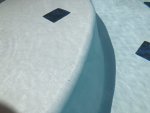 D9719151-6C34-491C-A10D-221DA124C273.jpeg207.2 KB · Views: 83
D9719151-6C34-491C-A10D-221DA124C273.jpeg207.2 KB · Views: 83 -
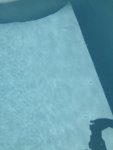 23A8A03E-A6AA-407A-8537-5B5E501C14F4.jpeg163.3 KB · Views: 82
23A8A03E-A6AA-407A-8537-5B5E501C14F4.jpeg163.3 KB · Views: 82
Thanks for your insight. I know how diligent I am with testing the water- I can guarantee that 95% of people would not be as crazy as me with testing and balancing. This was an unseen expense on a new house that we did because we needed to replace our leaking skimmer and 40 year old pump. Having to do all that work we figured we might as well do the surface, the old one was stained and definitely damaged with chem neglect from previous homeowner- previous owner was the opposite of handy. We were so excited to enjoy our “brand new” pool- it was so nice at first it looked like smooth mashed potatoes  and then this happened right away. Super frustrating.
and then this happened right away. Super frustrating.
hburke,
Thanks for providing more photos. The second photo seems to show some spotting issues and what is known as "white soft spotting" (also known as spot etching). The other photos are somewhat blurry and difficult to tell for sure. The spotting that I see isn't very severe. It could be that the spotting will worsen over time due to the nature of the problem.
This link will explain what might be happening to your pool.
 www.troublefreepool.com
www.troublefreepool.com
Please provide the current chemical readings of your pool water and also from the source (truck) water that was used to fill the pool when new.
Since you believe that the builder is honest, I suggest you provide him with that article about white spotting and show him your water chemistry records and see what he has to say. If you feel the spotting is not acceptable, I believe that polishing the plaster surface where the spotting is will be your best option to pursue.
Thanks for providing more photos. The second photo seems to show some spotting issues and what is known as "white soft spotting" (also known as spot etching). The other photos are somewhat blurry and difficult to tell for sure. The spotting that I see isn't very severe. It could be that the spotting will worsen over time due to the nature of the problem.
This link will explain what might be happening to your pool.
White Spotting of New Plaster Pools
The problem of plaster spotting has been an ongoing puzzle and controversy in the swimming pool industry for over three decades. The generally round, smooth-yet-unsightly white soft spots in new plaster pools have long been a source of contention among pool plasterers, and pool chemical service...
Please provide the current chemical readings of your pool water and also from the source (truck) water that was used to fill the pool when new.
Since you believe that the builder is honest, I suggest you provide him with that article about white spotting and show him your water chemistry records and see what he has to say. If you feel the spotting is not acceptable, I believe that polishing the plaster surface where the spotting is will be your best option to pursue.
I need to get some photos when there is less wind- it’s hard to take them in the deeper areas, but some of the streaking and spotting is pretty noticeable. Readings now are: temp:81 fc: 2.5 ph 7.7 calcium 240 alkalinity 100 stabilizer:30 salt/tds: 700. I don’t have readings for the water truck. Ph has never been below 7.6. We followed detailed instructions following the fill to adjust to specific levels. Following that we use the Orenda app for LSU calculation. It has never been under saturated since the ph tends to be high. Last year we added acid almost daily to stay between 7.6-7.8. Thanks for the link- that is exactly what I first found that led me to believe this is what we are experiencing. Does this problem lead to major degradation of the plaster at some point- or is it mainly asthetic? Seems like there is not much that can be done at this point, since sanding/polishing does not affect the spots at all.
instructions we followed immediately after plaster job:
Day 1.
• brush pool twice (morning and then afternoon or evening) • adjust water chemistry
#1: Alkalinity level
Test and adjust alkalinity
• test alkalinity and adjust to 80ppm to 100ppm • proper alkalinity level helps stabilize pH
NOTE: after 28 days, alkalinity range expands to 80ppm to 120ppm
Low alkalinity will cause volatility with your pH level • add alkalinity increaser (sodium bicarbonate)
to raise alkalinity
High alkalinity will cause your pH level to be rigidly fixed and may cause scale and cloudiness
• add sodium bisulfate or muriatic acid to lower alkalinity
NOTE: sodium bisulfate can discolor plaster where the granular rests; first, dilute granular in bucket of water (always follow product label instructions)
#2: pH level
Test and adjust pH
• test pH and adjust level to 7.2 to 7.6
NOTE: Sodium bisulfate can discolor plaster where the granular rests; first, dilute granular in bucket of water (always follow product label instructions)
Day 2
• brush pool twice (morning and then afternoon or evening)
• adjust water chemistry
#1: Alkalinity level - same instructions as Day 1 #2: pH level - same instructions as Day 1
Day 3
• brush pool twice (morning and then afternoon or evening)
• adjust water chemistry
#1: Alkalinity level - same instructions as Day 1
#2: pH level - same instructions as Day 1 #3: Chlorine level
Test and adjust chlorine:
• add chlorine (in tablet or granular) to a achieve an ideal level of 1.5 to 2.0 ppm
Day 4
• brush pool twice (morning and then afternoon or evening) • adjust water chemistry
#1: Alkalinity level - same instructions as Day 1 #2: pH level - same instructions as Day 1
#3: Chlorine level - same instructions as Day 3 #4: Calcium hardness (aka: total hardness) Test and adjust calcium hardness:
• test calcium hardness and adjust to 200ppm
NOTE: after 28 days, calcium range expands to 200ppm to 400ppm
Day 5
• brush pool twice (morning and then afternoon or evening) • adjust water chemistry
#1: Alkalinity level - same instructions as Day 1
#2: pH level - same instructions as Day 1
#3: Chlorine level - same instructions as Day 3
#4: Calcium hardness – same instructions as Day 4 #5: Cyanuric acid level
Test and adjust cyanuric acid:
• test and adjust to 30ppm to 50ppm
Day 6 through Day 28
#1: Alkalinity level - same instructions as Day 1
#2: pH level - same instructions as Day 1
#3: Chlorine level - same instructions as Day 3
#4: Calcium hardness - same instructions as Day 4
#5: Cyanuric acid level - same instructions as Day 5
instructions we followed immediately after plaster job:
Day 1.
• brush pool twice (morning and then afternoon or evening) • adjust water chemistry
#1: Alkalinity level
Test and adjust alkalinity
• test alkalinity and adjust to 80ppm to 100ppm • proper alkalinity level helps stabilize pH
NOTE: after 28 days, alkalinity range expands to 80ppm to 120ppm
Low alkalinity will cause volatility with your pH level • add alkalinity increaser (sodium bicarbonate)
to raise alkalinity
High alkalinity will cause your pH level to be rigidly fixed and may cause scale and cloudiness
• add sodium bisulfate or muriatic acid to lower alkalinity
NOTE: sodium bisulfate can discolor plaster where the granular rests; first, dilute granular in bucket of water (always follow product label instructions)
#2: pH level
Test and adjust pH
• test pH and adjust level to 7.2 to 7.6
NOTE: Sodium bisulfate can discolor plaster where the granular rests; first, dilute granular in bucket of water (always follow product label instructions)
Day 2
• brush pool twice (morning and then afternoon or evening)
• adjust water chemistry
#1: Alkalinity level - same instructions as Day 1 #2: pH level - same instructions as Day 1
Day 3
• brush pool twice (morning and then afternoon or evening)
• adjust water chemistry
#1: Alkalinity level - same instructions as Day 1
#2: pH level - same instructions as Day 1 #3: Chlorine level
Test and adjust chlorine:
• add chlorine (in tablet or granular) to a achieve an ideal level of 1.5 to 2.0 ppm
Day 4
• brush pool twice (morning and then afternoon or evening) • adjust water chemistry
#1: Alkalinity level - same instructions as Day 1 #2: pH level - same instructions as Day 1
#3: Chlorine level - same instructions as Day 3 #4: Calcium hardness (aka: total hardness) Test and adjust calcium hardness:
• test calcium hardness and adjust to 200ppm
NOTE: after 28 days, calcium range expands to 200ppm to 400ppm
Day 5
• brush pool twice (morning and then afternoon or evening) • adjust water chemistry
#1: Alkalinity level - same instructions as Day 1
#2: pH level - same instructions as Day 1
#3: Chlorine level - same instructions as Day 3
#4: Calcium hardness – same instructions as Day 4 #5: Cyanuric acid level
Test and adjust cyanuric acid:
• test and adjust to 30ppm to 50ppm
Day 6 through Day 28
#1: Alkalinity level - same instructions as Day 1
#2: pH level - same instructions as Day 1
#3: Chlorine level - same instructions as Day 3
#4: Calcium hardness - same instructions as Day 4
#5: Cyanuric acid level - same instructions as Day 5
Thank you for that information and I look forward to some more photos. The current water balance is good, which you already know.
I consider "white spotting/streaking" somewhere between a major degradation and a minor degradation in addition to the noticeable discoloration contrast. Unfortunately, the degradation of the affected spots and areas usually gets worse over time and the discoloration gets worse too no matter what. It will depend on the degree of the original damage done during the finishing operation, and also the water balance can have an effect. Good water balance slows down rapid degradation, and poor water balance will just make it worse much faster.
Forgive me, but I want to respond to lasvegaspools comments with my next post.
I consider "white spotting/streaking" somewhere between a major degradation and a minor degradation in addition to the noticeable discoloration contrast. Unfortunately, the degradation of the affected spots and areas usually gets worse over time and the discoloration gets worse too no matter what. It will depend on the degree of the original damage done during the finishing operation, and also the water balance can have an effect. Good water balance slows down rapid degradation, and poor water balance will just make it worse much faster.
Forgive me, but I want to respond to lasvegaspools comments with my next post.
Last edited:
To @lasvegaspools
Since you are aware of both side’s research and studies, then you should know that similar plaster studies that you are requesting have already been performed. The NPC conducted four years (2004 – 2008) of plaster experiments with 12 test pools at Cal Poly SLO. The NPC received about one million dollars from the industry towards that effort. Side note: Our requests to participate and help with their test pool studies were rejected.
Cal Poly provided four yearly reports (about 100 pages each) with detailed information showing that some test pools maintained with aggressive water did NOT cause or result in white spots, streaking, discoloration, or calcium nodules developing within a 10 month study. Conversely, some of their test pools that had balanced water resulted in white spots and gray discoloration developing within four months. Since white spotting and graying occurred in balanced water, on what basis do you suggest that aggressive water must be involved with causing those issues?
Additionally, during the past twenty years, onBalance has had three different professional cement labs analyze various plaster samples from white spotted pools. All labs stated that NO aggressive water (etching) effects were found on the plaster surface, but that the plaster surface had been compromised by poor troweling workmanship.
It was determined that calcium hydroxide (a cement byproduct) had been leached out (by balanced water) causing increased porosity and a whitening effect in specific areas or spots. It is known that calcium hydroxide and calcium chloride (the hardening accelerator that plasterers like to add and use) are both soluble in LSI (or CSI) balanced water. This simply means that a compromised plaster surface can allow balanced (or aggressive) water to penetrate the surface and dissolve away calcium hydroxide and calcium chloride and thereby creating a porous surface that slowly degrades and turns whitish over time.
Is it your position (along with the NPC) that slightly aggressive water not only causes white spots, streaks, and blotchiness, but also causes calcium nodules, severe craze cracking (shrinkage), and gray mottling discoloration? If so, why is it that many plasterers insist on performing severe acid treatments to remedy some of those plaster problems? Is that not contradictory?
The NPC suggests that any negative LSI (even -0.1 to -0.3) will cause visible plaster deterioration and discoloration problems. Don’t you find that a little bit ridiculous? And where is their supporting documentation and evidence of that?
As I mentioned before, we are building two test pools for conducting additional plaster research experiments. We are pursuing this even though we have very limited funds. We proposed a joint research project with the NPC to assist and contribute. They rejected it.
In summary, our side has documented science which is also supported by literature from the ACI and PCA. Is there any credible evidence or supporting information of the NPC’s position?
Since you are aware of both side’s research and studies, then you should know that similar plaster studies that you are requesting have already been performed. The NPC conducted four years (2004 – 2008) of plaster experiments with 12 test pools at Cal Poly SLO. The NPC received about one million dollars from the industry towards that effort. Side note: Our requests to participate and help with their test pool studies were rejected.
Cal Poly provided four yearly reports (about 100 pages each) with detailed information showing that some test pools maintained with aggressive water did NOT cause or result in white spots, streaking, discoloration, or calcium nodules developing within a 10 month study. Conversely, some of their test pools that had balanced water resulted in white spots and gray discoloration developing within four months. Since white spotting and graying occurred in balanced water, on what basis do you suggest that aggressive water must be involved with causing those issues?
Additionally, during the past twenty years, onBalance has had three different professional cement labs analyze various plaster samples from white spotted pools. All labs stated that NO aggressive water (etching) effects were found on the plaster surface, but that the plaster surface had been compromised by poor troweling workmanship.
It was determined that calcium hydroxide (a cement byproduct) had been leached out (by balanced water) causing increased porosity and a whitening effect in specific areas or spots. It is known that calcium hydroxide and calcium chloride (the hardening accelerator that plasterers like to add and use) are both soluble in LSI (or CSI) balanced water. This simply means that a compromised plaster surface can allow balanced (or aggressive) water to penetrate the surface and dissolve away calcium hydroxide and calcium chloride and thereby creating a porous surface that slowly degrades and turns whitish over time.
Is it your position (along with the NPC) that slightly aggressive water not only causes white spots, streaks, and blotchiness, but also causes calcium nodules, severe craze cracking (shrinkage), and gray mottling discoloration? If so, why is it that many plasterers insist on performing severe acid treatments to remedy some of those plaster problems? Is that not contradictory?
The NPC suggests that any negative LSI (even -0.1 to -0.3) will cause visible plaster deterioration and discoloration problems. Don’t you find that a little bit ridiculous? And where is their supporting documentation and evidence of that?
As I mentioned before, we are building two test pools for conducting additional plaster research experiments. We are pursuing this even though we have very limited funds. We proposed a joint research project with the NPC to assist and contribute. They rejected it.
In summary, our side has documented science which is also supported by literature from the ACI and PCA. Is there any credible evidence or supporting information of the NPC’s position?
@onBalance thank you for the info- I found a couple photos that I sent to the pool company right before closing last year which I feel illustrates the issue. That first picture is a close up of the dry top step when we were closing for winter- I feel like this is a good view of what is happening. This is the same texture/issue across the whole pool. In person, the contrast is more pronounced with the rest of the pictures- just come out a bit dark with the water. It has definitely gotten worse over time but I am hoping it is leveling out at the 2nd year.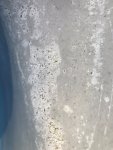

Attachments
I agree with OnBalance.
Simple logic says that if the plaster is uniform, any aggressive water would result in uniform effects.
If the effects are not uniform, it's a plaster issue.
Simple logic says that if the plaster is uniform, any aggressive water would result in uniform effects.
If the effects are not uniform, it's a plaster issue.
Let me be clear, I said I do not believe either side is 100% correct, I did say is it is likely a combination of factors. For either side to be proven correct one should be able to spec a mix and parameters for plaster application. State what water chemistry and length of time and create spot etching and other plaster finishes issues. This should be able to be reproduced over and over again. This would be undisputed proof for either side. I will keep my answer the same, it is likely a combination of factors, until this can be done.
Lastly I have not endorsed or defended either side. I just try to provide information based on my experience when a question is asked. I would imagine that most readers don't even realize the back and fourth that has been ongoing for decades.
Lastly I have not endorsed or defended either side. I just try to provide information based on my experience when a question is asked. I would imagine that most readers don't even realize the back and fourth that has been ongoing for decades.
@lasvegaspools, Please provide the basis for your belief that water chemistry is likely involved in the development of the various plaster problems mentioned above.
I am curious before I answer your question why you have not answered mine. Spec the plaster mix, application method, start up procedures and chemical maintenance. Then give me a time frame for the pool to "spot etch". I think knowing the exact cause it would be reasonable for this to happen with 60 days of completion. Then reproduce it again and again. Until then I will believe that there are likely multiple factors.
Not trying to bore anybody but here we go.
A properly mixed and troweled plaster surface can be etched by aggressive water, but only uniformly across its surface. When the pattern of spotting is nonuniform, something other than water chemistry is at fault.
— Kim Skinner, co-founder, onBalance
“Regardless of what terminology you use, you’re still talking about a chemical being drawn out of a mixture,” says James Schmitt, president of Schmitt Technical Services in Madison, Wis., a consulting firm that specializes in chemical analyses of geological and construction materials. “Yes, weaker areas of the plaster are more likely to develop spots — and aggressive water is more likely to attack those weak areas. These causes and effects influence one another.”
As far as causes, it’s my opinion that water chemistry is an important factor in spotting — and so is the quality and workmanship of the plaster. It’s all about the interactions between these factors, rather than just one or the other.
— David Rothstein, president, DRP Consulting Inc. , Boulder, Colo.
“I absolutely think water chemistry, plaster mixes and plaster application can all play a part in causing these spots,” says Laura Powers, associate principal at Wiss, Janney, Elstner Associates Inc. in Northbrook, Ill., a firm specializing in structural, architectural and materials analysis. “When I study core samples of spotted plaster, I can’t say that the microcracks I see were caused by water chemistry because those are clearly due to troweling. But I also can’t say that the secondary porosity I see is caused by troweling because that’s clearly a water chemistry issue.”
This isn’t a simple black-and-white issue. Pool water can be quite aggressive toward plaster, and can etch it and produce soft spots. But, at the same time, weaker areas of plaster will be more susceptible to attack by aggressive water. Spotting can be due to one or the other — or to both.
— Robert O’Neill, senior petrographer, Micro-Chem Laboratories , Murphys, Calif.
many scientists agree that plaster workmanship is a contributing factor — sometimes a major one — in cases of spotting, the hypothesis that aggressive water chemistry is never a factor just doesn’t fit neatly with all the data they’ve examined.
When your test pool are done I will read the info and my mind may change. Do you have a date projected date for this yet?
Not trying to bore anybody but here we go.
A properly mixed and troweled plaster surface can be etched by aggressive water, but only uniformly across its surface. When the pattern of spotting is nonuniform, something other than water chemistry is at fault.
— Kim Skinner, co-founder, onBalance
“Regardless of what terminology you use, you’re still talking about a chemical being drawn out of a mixture,” says James Schmitt, president of Schmitt Technical Services in Madison, Wis., a consulting firm that specializes in chemical analyses of geological and construction materials. “Yes, weaker areas of the plaster are more likely to develop spots — and aggressive water is more likely to attack those weak areas. These causes and effects influence one another.”
As far as causes, it’s my opinion that water chemistry is an important factor in spotting — and so is the quality and workmanship of the plaster. It’s all about the interactions between these factors, rather than just one or the other.
— David Rothstein, president, DRP Consulting Inc. , Boulder, Colo.
“I absolutely think water chemistry, plaster mixes and plaster application can all play a part in causing these spots,” says Laura Powers, associate principal at Wiss, Janney, Elstner Associates Inc. in Northbrook, Ill., a firm specializing in structural, architectural and materials analysis. “When I study core samples of spotted plaster, I can’t say that the microcracks I see were caused by water chemistry because those are clearly due to troweling. But I also can’t say that the secondary porosity I see is caused by troweling because that’s clearly a water chemistry issue.”
This isn’t a simple black-and-white issue. Pool water can be quite aggressive toward plaster, and can etch it and produce soft spots. But, at the same time, weaker areas of plaster will be more susceptible to attack by aggressive water. Spotting can be due to one or the other — or to both.
— Robert O’Neill, senior petrographer, Micro-Chem Laboratories , Murphys, Calif.
many scientists agree that plaster workmanship is a contributing factor — sometimes a major one — in cases of spotting, the hypothesis that aggressive water chemistry is never a factor just doesn’t fit neatly with all the data they’ve examined.
When your test pool are done I will read the info and my mind may change. Do you have a date projected date for this yet?
HBurke,
Your close-up photo of the plaster with damaged and rough white areas is indicative of the "white spotting" problem. The areas around the white spots are smooth and also darker in color. As I stated earlier, provide a copy of the article about "White Spotting" to the builder or plaster contractor and suggest that this problem is due to improper workmanship and materials. That includes excessive water troweling. late hard troweling, and probably too much calcium chloride was added to the plaster mix.
There is also this article that provides additional info. Scientific Evidence on Plaster Spotting
In case you are wondering, I plan to respond to LasVegasPools recent comments later today.
Your close-up photo of the plaster with damaged and rough white areas is indicative of the "white spotting" problem. The areas around the white spots are smooth and also darker in color. As I stated earlier, provide a copy of the article about "White Spotting" to the builder or plaster contractor and suggest that this problem is due to improper workmanship and materials. That includes excessive water troweling. late hard troweling, and probably too much calcium chloride was added to the plaster mix.
There is also this article that provides additional info. Scientific Evidence on Plaster Spotting
In case you are wondering, I plan to respond to LasVegasPools recent comments later today.
Last edited:
@lasvegaspools
Thank you for sharing your perspective about plaster spotting.
Point One: Regarding the statements (that you provided in your post above) from several cement petrographers. It is important to realize that when discussing the dissolving capabilities of water, some statements can be easily misunderstood. And I believe that is the case with those statements.
I will try my best to explain in detail. Not all petrographers are chemists (and especially not pool water chemists), and we learned years ago that some petrographers consider the dissolution (dissolving) of any cement/plaster material as being an “aggressive action” by water regardless of what the LSI is. Since the LSI only predicts solubility of the carbonate form of calcium, and the hydroxide form can be soluble up to a pH of 10, the LSI as used in the pool industry is not always being considered when petrographers make statements about “aggressive” water.
First, with respect to water dissolving calcium carbonate (a relatively insoluble and major component of plaster), the entire pool industry (including onBalance) would agree that the water must be LSI aggressive to do this because balanced water does not generally dissolve calcium carbonate. If, however, the discussion is about the dissolution of calcium hydroxide (a soluble and 25% component of hardened cement/plaster), some petrographers (that are not considering the LSI) may still describe that dissolution of soluble calcium hydroxide by (LSI balanced) water as being an aggressive action. But a chemist (and understanding the LSI) would probably say that calcium hydroxide simply dissolves or will be “leached out” (a non-aggressive phenomenon) with the presence of water. In fact, calcium hydroxide is soluble enough to be dissolved (leached) away by even positive LSI water. And that is what is often taking place with spotted pool plaster. That is a major distinction to understand about this issue of spotting.
When analyzing spotted plaster, one must take the LSI into consideration when making statements about the water and what kind of water is dissolving calcium hydroxide. Otherwise, such statements can be easily misinterpreted and lead people into thinking that LSI aggressive water was the reason for the dissolving of calcium hydroxide and leading to white spotting.
It appears that water needs to be at least above an LSI of about +1.0 to not be aggressive towards and dissolve calcium hydroxide. (And even a higher LSI with respect to the extremely soluble calcium chloride (another typical plaster component).
It is that fact about the solubility of calcium hydroxide that plaster/NPC leaders are misrepresenting. They continue suggest that only LSI aggressive water dissolves calcium hydroxide. They put out a false narrative to mislead the industry and pool owners and to hide behind.
Therefore, quoting a general statement from a petrographer without context in this light does not further the understanding… one needs to nail them down on what “aggressive” means in terms of the actual plaster components exposed to the water. “Water chemistry,” whether balanced or aggressive, does play a role in the development of spotting, because without water, no dissolution occurs.
Point Two: You are mispresenting our position. onBalance has never suggested that aggressive water is never a factor in some spotted pools. If a plaster surface is compromised by poor troweling, then LSI aggressive water will likely cause spotting to occur much faster than would with balanced water. If however, the plaster surface has not been compromised with poor troweling aspects, then LSI aggressive water will uniformly etch the plaster surface, and there will not be a major whitening of the surface. In fact, you probably know that aggressive water (and acid treatments) does not turn colored plaster white. Instead, it brings out the original color.
We agree with the statements that if a poorly troweled plaster pool is maintained with LSI aggressive water, that aggressive water will certainly attack those compromised areas (soft plaster areas including craze cracks, plaster-to-tile transitions, and spots) quickly and result in white areas developing much faster than would happen with balanced water.
Also, with an aggressive condition, the surrounding areas (non-spotted) will also show etching effects. And that is what a petrographer can determine. So far, we have primarily sent unetched samples we obtained from failed plaster pools to petrographers. In one instance, however, the plaster had been previously acid washed. Therefore, in all but one of the cases the petrographers did NOT see any etching effects. That is evidence that aggressive water is not necessary to cause white spots. In the one etched sample the petrographer had to closely analyze to see the effects of the spotting since the later etching obliterated some of the surface features.
Is it your opinion that aggressive water is required to develop white spotting?
The bottom line here is that the plaster leaders know that they have no study and no science to support their position. I believe they know that calcium hydroxide can be dissolved by LSI balanced water. And I believe they know that the Cal Poly studies provided evidence that spotting can occur in balanced water.
As to your test pool challenge:
The onus is not on us to prove our position. We have retained four labs to study and analyze plaster samples and determine what causes white spotting and streaks. Their findings indicate that aggressive water is not required to generate white spots and streaks. Even the NPC’s Cal Poly test pools demonstrated the same outcome. If you feel we are wrong, and you are sure of your position, then the onus is on you to prove that.
We have already spent thousands of dollars of our own money to determine and verify a cause and effect. You can’t ignore the evidence that we have produced, and simply say we need to do more.
Balanced “water chemistry” does enable the slow and selective dissolving of the soluble compounds such as calcium hydroxide and calcium chloride. If the water is aggressive, the spotting should happen faster, but the aggressiveness is not causative.
As you say, there are multiple factors that contribute to white spotting development; water/cement ratios, water troweling (how much?), adding calcium chloride (how much?) and late hard troweling, and spraying down a pool before filling, etc. Telling us to predict when spotting will become visible is next to impossible because of the complexity of this complicated plaster defect.
Your challenge to conduct a test pool study with your set of criteria is virtually impossible. And ignores the science and what has already been proven by petrographers. The NPC should know how to spot a pool. They produced spotted plaster in several balanced water test pools at Cal Poly and filmed the troweling. But they haven’t shared their video with the industry. Perhaps they will share it with you.
It appears that you and the NPC are ignoring the fact that soluble calcium hydroxide is what gets dissolved away while leaving calcium carbonate on the surface. That reality is what proves that aggressive water is not required to cause spots, streaks, and blotchiness. But that is not to suggest that aggressive water is never part of some spotted pools. But when aggressive water is involved, it will also show etching (roughness) of a carbonated surface of the areas surrounding the compromised and porous whitened spots and streaks.
You used a Laura Powers quote. Did you know that she came up with a mechanical model for the cause of spotting?
Regarding our Test Pools: We do not have a projected finish date because of continuing delays in trying to obtain sufficient money, equipment, materials, and assistance. There have been active attempts by some to delay or sabotage assistance in this endeavor. I personally have been donating several thousand dollars each year towards this effort. We could use some help.
Lastly, I find it inconsistent and illogical for plasterers to claim that maintaining a moderately negative LSI water is a definite causative factor for spotting, and yet, they commonly perform strong acid treatments immediately after plastering or during start-ups and afterwards, and THAT does not contribute at all to spotting? Can you explain that reasoning?
And I have a question: Is it your position regarding gray mottling, spalling, and calcium nodules, that aggressive water causes those defects too?
Addendum:
When petrographers examine actual spotted plaster, instead of just making general comments, they say things like:
· Dr. Mengesha A. Beyene, Dr. Michael Silsbee and Niles Thaulow at the RJ Lee Group: “…relatively high water-to-cement ratio compared to the surrounding paste.” “…the porous, high water-to-cement ratio areas near the surface spots are likely the result of poor finishing practices such as retempering the cement paste by adding extra water during finishing.” “If aggressive pool water caused the observed off-white features, it should have affected the whole plaster surface more or less uniformly.”
· Dr. Boyd Clark at CTL Group: “…associated with areas of increased porosity in the plaster, due to water driven ‘reconstruction’ of the hydrated cement paste.” “The chloride values are the same throughout the plaster indicating chloride was added to the plaster during placement and are much higher than industry recommendations…” “Past studies have indicated that the swimming pool spotting phenomenon becomes more pronounced with increasing chloride content.”
· Laura Powers at WJE: “…the discolored spots represent localized distress, as evidenced by the abundance of microcracks, softness of paste within the spot, high secondary porosity, and the re-distribution of paste constituents (leaching of calcium from calcium silicate hydrate and precipitation of secondary calcite.)” “The distress does not appear to have been caused by exposure to aggressive water;” “Troweling practices that expose aggregates at the surface risk producing avenues for water ingress along the paste-aggregate boundaries.”
· Ronald D. Sturm at River Bend Petrographics: “…localized leaching of paste constituent, leading to increased micro-porosity and permeability, and color changes to the cement paste associated with localized carbonation of the affected, leached paste.” “This localized increase in w/c is likely associated with finishing practices, including suspected addition of extra water to the surface during finishing.”
(These four observations above were all from samples of a single pool, sent to four different labs to confirm / peer review findings.)
Thank you for sharing your perspective about plaster spotting.
Point One: Regarding the statements (that you provided in your post above) from several cement petrographers. It is important to realize that when discussing the dissolving capabilities of water, some statements can be easily misunderstood. And I believe that is the case with those statements.
I will try my best to explain in detail. Not all petrographers are chemists (and especially not pool water chemists), and we learned years ago that some petrographers consider the dissolution (dissolving) of any cement/plaster material as being an “aggressive action” by water regardless of what the LSI is. Since the LSI only predicts solubility of the carbonate form of calcium, and the hydroxide form can be soluble up to a pH of 10, the LSI as used in the pool industry is not always being considered when petrographers make statements about “aggressive” water.
First, with respect to water dissolving calcium carbonate (a relatively insoluble and major component of plaster), the entire pool industry (including onBalance) would agree that the water must be LSI aggressive to do this because balanced water does not generally dissolve calcium carbonate. If, however, the discussion is about the dissolution of calcium hydroxide (a soluble and 25% component of hardened cement/plaster), some petrographers (that are not considering the LSI) may still describe that dissolution of soluble calcium hydroxide by (LSI balanced) water as being an aggressive action. But a chemist (and understanding the LSI) would probably say that calcium hydroxide simply dissolves or will be “leached out” (a non-aggressive phenomenon) with the presence of water. In fact, calcium hydroxide is soluble enough to be dissolved (leached) away by even positive LSI water. And that is what is often taking place with spotted pool plaster. That is a major distinction to understand about this issue of spotting.
When analyzing spotted plaster, one must take the LSI into consideration when making statements about the water and what kind of water is dissolving calcium hydroxide. Otherwise, such statements can be easily misinterpreted and lead people into thinking that LSI aggressive water was the reason for the dissolving of calcium hydroxide and leading to white spotting.
It appears that water needs to be at least above an LSI of about +1.0 to not be aggressive towards and dissolve calcium hydroxide. (And even a higher LSI with respect to the extremely soluble calcium chloride (another typical plaster component).
It is that fact about the solubility of calcium hydroxide that plaster/NPC leaders are misrepresenting. They continue suggest that only LSI aggressive water dissolves calcium hydroxide. They put out a false narrative to mislead the industry and pool owners and to hide behind.
Therefore, quoting a general statement from a petrographer without context in this light does not further the understanding… one needs to nail them down on what “aggressive” means in terms of the actual plaster components exposed to the water. “Water chemistry,” whether balanced or aggressive, does play a role in the development of spotting, because without water, no dissolution occurs.
Point Two: You are mispresenting our position. onBalance has never suggested that aggressive water is never a factor in some spotted pools. If a plaster surface is compromised by poor troweling, then LSI aggressive water will likely cause spotting to occur much faster than would with balanced water. If however, the plaster surface has not been compromised with poor troweling aspects, then LSI aggressive water will uniformly etch the plaster surface, and there will not be a major whitening of the surface. In fact, you probably know that aggressive water (and acid treatments) does not turn colored plaster white. Instead, it brings out the original color.
We agree with the statements that if a poorly troweled plaster pool is maintained with LSI aggressive water, that aggressive water will certainly attack those compromised areas (soft plaster areas including craze cracks, plaster-to-tile transitions, and spots) quickly and result in white areas developing much faster than would happen with balanced water.
Also, with an aggressive condition, the surrounding areas (non-spotted) will also show etching effects. And that is what a petrographer can determine. So far, we have primarily sent unetched samples we obtained from failed plaster pools to petrographers. In one instance, however, the plaster had been previously acid washed. Therefore, in all but one of the cases the petrographers did NOT see any etching effects. That is evidence that aggressive water is not necessary to cause white spots. In the one etched sample the petrographer had to closely analyze to see the effects of the spotting since the later etching obliterated some of the surface features.
Is it your opinion that aggressive water is required to develop white spotting?
The bottom line here is that the plaster leaders know that they have no study and no science to support their position. I believe they know that calcium hydroxide can be dissolved by LSI balanced water. And I believe they know that the Cal Poly studies provided evidence that spotting can occur in balanced water.
As to your test pool challenge:
The onus is not on us to prove our position. We have retained four labs to study and analyze plaster samples and determine what causes white spotting and streaks. Their findings indicate that aggressive water is not required to generate white spots and streaks. Even the NPC’s Cal Poly test pools demonstrated the same outcome. If you feel we are wrong, and you are sure of your position, then the onus is on you to prove that.
We have already spent thousands of dollars of our own money to determine and verify a cause and effect. You can’t ignore the evidence that we have produced, and simply say we need to do more.
Balanced “water chemistry” does enable the slow and selective dissolving of the soluble compounds such as calcium hydroxide and calcium chloride. If the water is aggressive, the spotting should happen faster, but the aggressiveness is not causative.
As you say, there are multiple factors that contribute to white spotting development; water/cement ratios, water troweling (how much?), adding calcium chloride (how much?) and late hard troweling, and spraying down a pool before filling, etc. Telling us to predict when spotting will become visible is next to impossible because of the complexity of this complicated plaster defect.
Your challenge to conduct a test pool study with your set of criteria is virtually impossible. And ignores the science and what has already been proven by petrographers. The NPC should know how to spot a pool. They produced spotted plaster in several balanced water test pools at Cal Poly and filmed the troweling. But they haven’t shared their video with the industry. Perhaps they will share it with you.
It appears that you and the NPC are ignoring the fact that soluble calcium hydroxide is what gets dissolved away while leaving calcium carbonate on the surface. That reality is what proves that aggressive water is not required to cause spots, streaks, and blotchiness. But that is not to suggest that aggressive water is never part of some spotted pools. But when aggressive water is involved, it will also show etching (roughness) of a carbonated surface of the areas surrounding the compromised and porous whitened spots and streaks.
You used a Laura Powers quote. Did you know that she came up with a mechanical model for the cause of spotting?
Regarding our Test Pools: We do not have a projected finish date because of continuing delays in trying to obtain sufficient money, equipment, materials, and assistance. There have been active attempts by some to delay or sabotage assistance in this endeavor. I personally have been donating several thousand dollars each year towards this effort. We could use some help.
Lastly, I find it inconsistent and illogical for plasterers to claim that maintaining a moderately negative LSI water is a definite causative factor for spotting, and yet, they commonly perform strong acid treatments immediately after plastering or during start-ups and afterwards, and THAT does not contribute at all to spotting? Can you explain that reasoning?
And I have a question: Is it your position regarding gray mottling, spalling, and calcium nodules, that aggressive water causes those defects too?
Addendum:
When petrographers examine actual spotted plaster, instead of just making general comments, they say things like:
· Dr. Mengesha A. Beyene, Dr. Michael Silsbee and Niles Thaulow at the RJ Lee Group: “…relatively high water-to-cement ratio compared to the surrounding paste.” “…the porous, high water-to-cement ratio areas near the surface spots are likely the result of poor finishing practices such as retempering the cement paste by adding extra water during finishing.” “If aggressive pool water caused the observed off-white features, it should have affected the whole plaster surface more or less uniformly.”
· Dr. Boyd Clark at CTL Group: “…associated with areas of increased porosity in the plaster, due to water driven ‘reconstruction’ of the hydrated cement paste.” “The chloride values are the same throughout the plaster indicating chloride was added to the plaster during placement and are much higher than industry recommendations…” “Past studies have indicated that the swimming pool spotting phenomenon becomes more pronounced with increasing chloride content.”
· Laura Powers at WJE: “…the discolored spots represent localized distress, as evidenced by the abundance of microcracks, softness of paste within the spot, high secondary porosity, and the re-distribution of paste constituents (leaching of calcium from calcium silicate hydrate and precipitation of secondary calcite.)” “The distress does not appear to have been caused by exposure to aggressive water;” “Troweling practices that expose aggregates at the surface risk producing avenues for water ingress along the paste-aggregate boundaries.”
· Ronald D. Sturm at River Bend Petrographics: “…localized leaching of paste constituent, leading to increased micro-porosity and permeability, and color changes to the cement paste associated with localized carbonation of the affected, leached paste.” “This localized increase in w/c is likely associated with finishing practices, including suspected addition of extra water to the surface during finishing.”
(These four observations above were all from samples of a single pool, sent to four different labs to confirm / peer review findings.)
Thread Status
Hello , This thread has been inactive for over 60 days. New postings here are unlikely to be seen or responded to by other members. For better visibility, consider Starting A New Thread.


